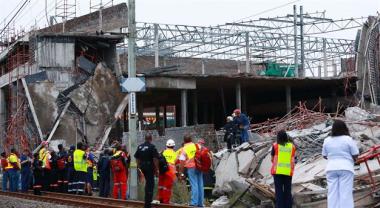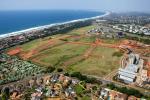Mudbricks much stronger than Concrete used at Tongaat Mall
 Construction company Gralio Precast had contracted Contest to test the concrete as the erection of Tongaat Mall progressed. Final readings in other sections in the unfinished mall showed 14MPa.
Construction company Gralio Precast had contracted Contest to test the concrete as the erection of Tongaat Mall progressed. Final readings in other sections in the unfinished mall showed 14MPa.
A commission of inquiry investigating the Tongaat Mall disaster, on Wednesday heard that mudbricks were stronger than the concrete used in the construction of the collapsed section.
The strength of concrete used in the ill-fated Tongaat mall was in places less than a third of what it should have been.
Testifying at the Commission of Inquiry, Phumudzo Maphaha, who is leading the inquiry into the mall's collapse, said that it was like mixing sand with water.
He was responding to test results presented by Contest laboratory manager Roderick Raw, who told the commission the final reading on day 28 found that the "cured concrete" was 9 megapascals, when the required standard is 30MPa.
Construction company Gralio Precast had contracted Contest to test the concrete as the erection of the mall progressed. Final readings in other sections in the unfinished mall showed 14MPa.
"This is very scary. This concrete failed to reach even half of what is required. That is a catastrophe. It means collapse. It was written all over these documents," Maphaha said. Two people died.
When asked why he had not contacted the contractor on the low results, Raw said they were sent to the client soon after the tests.
"The results are an alert in itself and any experienced person working with the contractor would have then read them and taken steps to rectify the problem," he said.
The concrete was tested at three days, seven days, and 28 days.
According to the design by the structural engineer Andre Ballack all concrete had to have a strength of 30Mpa after 28 days.
Bruce Zinn from Mega Pile, the company responsible for installing the piling that would have supported the mall, said during the construction he became aware that the load which some of piling would have to carry had been increased.
He said he had informed the engineers of his concerns.
One of the piles had a diameter insufficient to carry the weight of the structure, he said.
Earlier on Wednesday, the inquiry was told that Gralio was fined twice for failing to submit building plans and continuing construction despite being served with notices to stop.
Lungiswa Cemane, a law enforcement officer with the eThekwini metro municipality, told the inquiry that she visited the site on May 8 last year and told the foreman that the construction was illegal.
"We showed him the contravention notice and told him to stop building."
She said a fine was issued to a site foreman for R2,500 -- R1,000 for failing to comply with a notice to cease building and R1,500 for building without approved plans.
She waited for the workers to leave, but when she returned the next day, found them back on the site.
She then issued another site foreman, Rajan Haripersad, another fine of R2,500 and waited for the workers to leave. The fine issued to Haripersad was subsequently paid.
Building continued and she referred the matter to the eThekwini metro municipality's legal department. She visited the site several times and took photographs which she submitted to the municipality's legal department.
She sent a letter from the city's legal department to the developers.
The commission is expected to prepare a report of its findings and formulate recommendations.
These would be handed to the labour minister and National Prosecuting Authority for consideration.
The inquiry continues on Thursday.


















